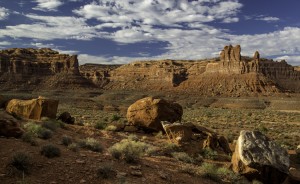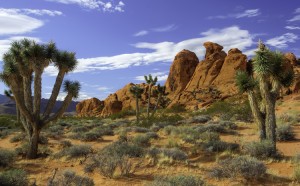Protection for Bears Ears and Gold Butte
January 12, 2017
On Dec. 28, 2016, President Barack Obama created two new large protected areas in the southwestern United States: the Bears Ears National Monument in southeastern Utah and Gold Butte National Monument in southern Nevada. To do so, the president used the executive power provided by the 1906 Antiquities Act. The act, meant to stop looting and destruction at prehistoric American Indian sites, gives the president the power to establish national monuments on federal land. Obama’s December actions protected some 2,500 square miles (6,475 square kilometers) of fragile and important desert landscapes, adding to his legacy of environmental protection.

Bears Ears National Monument in southeastern Utah protects one of the most significant cultural landscapes in the United States, an area with thousands of archaeological sites and other areas of beauty and importance. Credit: Bureau of Land Management
Bears Ears National Monument contains numerous sites considered sacred by Native American groups. The monument protects ancient petroglyphs (rock carvings), cliffside dwellings, and lands traditionally used by Navajo and other native groups to forage for wild plants used for food and herbal remedies. The protected lands will remain open for livestock grazing. The monument is to be administered by the Bureau of Land Management (BLM) and the U.S. Forest Service, in conjunction with an association representing native groups.

Gold Butte National Monument protects a beautiful and culturally significant desert landscape northeast of Las Vegas, Nevada. Credit: Bureau of Land Management
Gold Butte National Monument in southern Nevada contains striking rock formations, forests of Joshua trees, ancient Native American sites, rare fossils, and a number of ecologically sensitive areas. The monument, known to many as “Nevada’s Piece of the Grand Canyon,” will continue to allow such recreational activities as hunting and fishing.
Conservationists, Native American groups, and many others applauded the president’s actions. Opponents of the monument designations included state legislators and county leaders who preferred the lands be used for mineral and fossil fuel exploration.
Theodore Roosevelt was the first president to use the Antiquities Act when he protected Wyoming’s Devils Tower in 1906. In 1908, Roosevelt also set aside 1,250 square miles (3,200 square kilometers) in Arizona’s Grand Canyon, creating a forerunner of the popular national park. Since taking office in 2009, Obama has used the Antiquities Act more than any other president, establishing or expanding more than two dozen new national monuments.
Throughout Obama’s presidency, his administration has taken numerous steps to combat global climate change, promote energy efficiency, and create or extend protections in areas of scenic, historic, and ecological importance.


